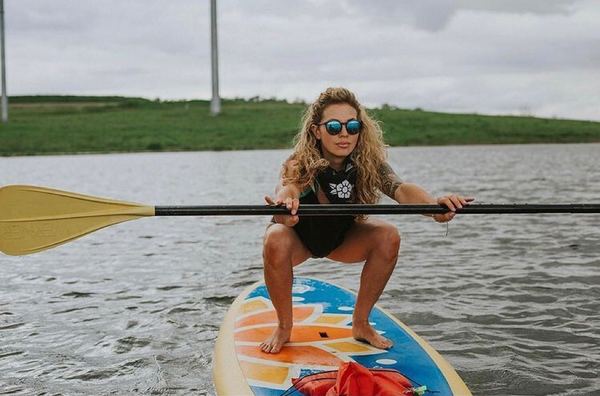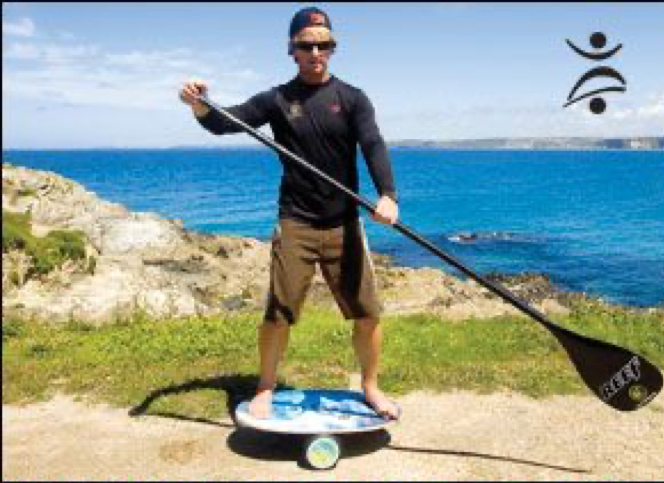
3 Balance Practices to Improve your SUP Balance
Master balance on your paddle board with three proven SUP balance practices that build core strength, stability, and body control on the water.
Improving your SUP balance comes down to three pillars: core strength, lower-body stability, and upper-body control.
Through targeted training—on land and on water—you’ll develop the agility, awareness, and strength to glide confidently across any surface.
The more you train balance, the more effortless paddle boarding becomes.
Table of contents
Understanding Balance: The Foundation of SUP Mastery
Balance is the heart of stand-up paddleboarding. It’s what keeps you upright, efficient, and confident whether you’re on glass-calm lakes or choppy waves. Maintaining balance requires coordination between your core muscles, lower body, and upper body, as well as sensory input from your eyes and inner ear (the vestibular system).
As we age or recover from injuries, our balance can naturally decline. That’s why intentional balance training—both on and off the water—is critical for every paddler who wants to improve stability and control. To improve SUP balance, read on.

Tips to Improve SUP Balance
1. Core Training: The Epicenter of SUP Balance
Your core connects your upper and lower body, acting as the stabilizing anchor for every paddle stroke. A strong core reduces fatigue, improves endurance, and minimizes wobble on your board.
Core-Strengthening Tools and Exercises
-
Balance Ball Workouts: Begin with planks or knee straddles on a stability ball. Focus on maintaining control rather than duration—your abs and back should engage together.
-
Bosu Ball Balancing: Stand or kneel on the dome side, performing movements like bent-over rows or slow torso rotations to challenge your balance dynamically.
-
Indo Board Mastery: Once you’re comfortable on the Bosu, step up to an Indo board. Use a resistance band to simulate paddle strokes—this mimics the shifting forces of real-world SUP balance.
Pro Tip: Try performing slow paddle motions while standing on a balance board to mimic on-water conditions. Keep your knees soft and your gaze forward.
2. Lower-Body Strength: The Power of One-Legged Control
Strong legs are the silent heroes of every steady paddle boarder. Your glutes, quads, calves, and the 100 tiny muscles in your feet all play crucial roles in maintaining stability.
Key Exercises for Lower-Body Stability
-
Single-Leg Squats: Begin with shallow one-legged squats to build strength and balance. As you improve, progress to deeper pistol squats for maximum control.
-
Step-Ups with Knee Lift: Mimic the shift in body weight used when adjusting on your board. Step onto a platform or bench, drive one knee up, and slowly lower.
-
Foot Strengthening Drills: Perform simple toe curls, arch lifts, and towel scrunches to strengthen foot muscles and improve your proprioception—the body’s sense of position.
Pro Tip: Practice balancing barefoot on uneven surfaces (like a foam pad or yoga mat). This wakes up stabilizing muscles often neglected by shoes.

3. Upper-Body Conditioning: For Stability and Paddle Power
Your upper body not only propels you forward but also helps stabilize your torso through every stroke. Shoulder and upper-back strength protect your joints and improve leverage on the paddle.
Effective Upper-Body Workouts
-
Rear Deltoid Raises: Using light dumbbells, hinge at the hips and lift your arms laterally to strengthen rear delts and traps—key for maintaining posture on your SUP.
-
Resistance-Band Pull-Apart: Holding a resistance band, stretch it outward until it reaches chest width. This exercise reinforces shoulder stability and posture.
-
Rotational Core Twists: With a resistance band anchored to the side, simulate paddle motions by rotating your torso slowly while keeping your hips stable.
Pro Tip: Focus on form, not weight. Good technique improves endurance and prevents shoulder fatigue during long sessions.
Bonus: Integrating Balance Into Your Routine
To make real progress, aim to train balance at least three times per week. Start with land-based exercises, then transfer those skills to your board by practicing slow turns, step-back pivots, and shifting stances.
Once confident, close your eyes during land-based drills to enhance your proprioceptive response—this trains your body to react instinctively to board movement without relying on sight.
Sample 20-Minute Weekly Balance Circuit
-
3 minutes of dynamic warm-up (arm circles, leg swings, torso twists)
-
4 minutes of core ball planks and side crunches
-
4 minutes of single-leg squats and calf raises
-
3 minutes of Bosu-ball paddle-mimicking drills
-
3 minutes of rear deltoid and shoulder-band work
-
3 minutes of mindful cool-down and breathing

Final Thoughts
Balance isn’t just about standing upright—it’s the foundation for every paddle stroke, turn, and recovery on your SUP. By strengthening your core, legs, and shoulders, you build confidence that translates to smoother rides, fewer falls, and longer, more enjoyable sessions.
Commit to regular training, stay patient with your progress, and remember: improving your SUP balance is a lifelong practice that pays off in every season.
FAQs
How long does it take to improve SUP balance?
Most paddlers notice improvement within 2–4 weeks of consistent training. The key is regular practice that challenges your stability in progressive ways.
Can I improve my paddle board balance without being on the water?
Absolutely. Tools like Bosu balls, Indo boards, and balance pads are perfect for replicating on-board conditions at home.
What if I keep falling while practicing?
That’s normal! Falling means you’re pushing your limits. Use calm water, soft landings, and keep knees slightly bent—confidence grows from controlled practice.
Should I wear shoes when training for SUP balance?
Barefoot training helps strengthen your feet and improve balance feedback, but use caution on hard or uneven surfaces.
How can yoga help with SUP balance?
Yoga enhances flexibility, body awareness, and breath control—all of which improve your poise and balance on the board.
How does wind or choppy water affect SUP balance?
Wind and waves add instability, challenging even experienced paddlers. Beginners should practice balance exercises on calm water before venturing into rougher conditions. Training your core and lower body on land prepares you to adapt quickly when the water isn’t perfectly still.





